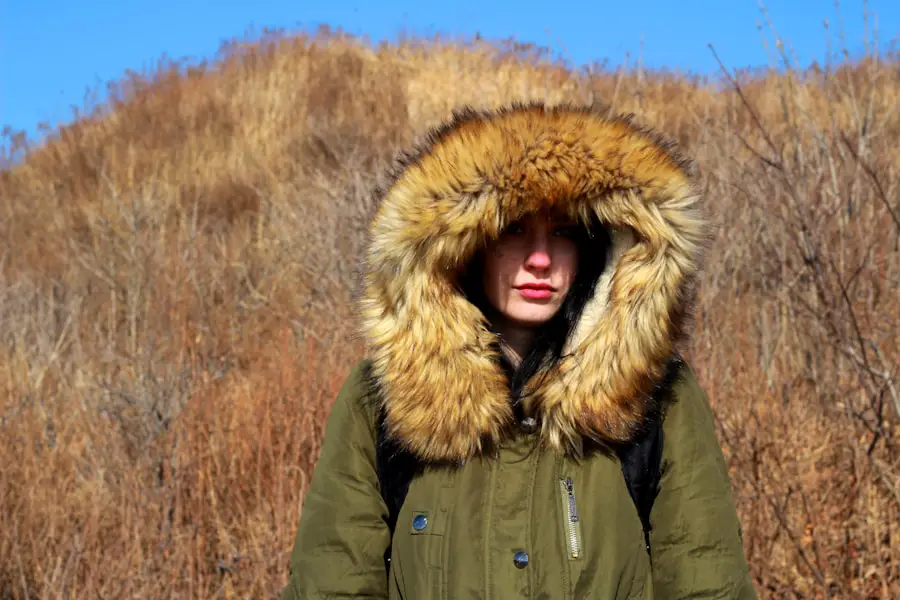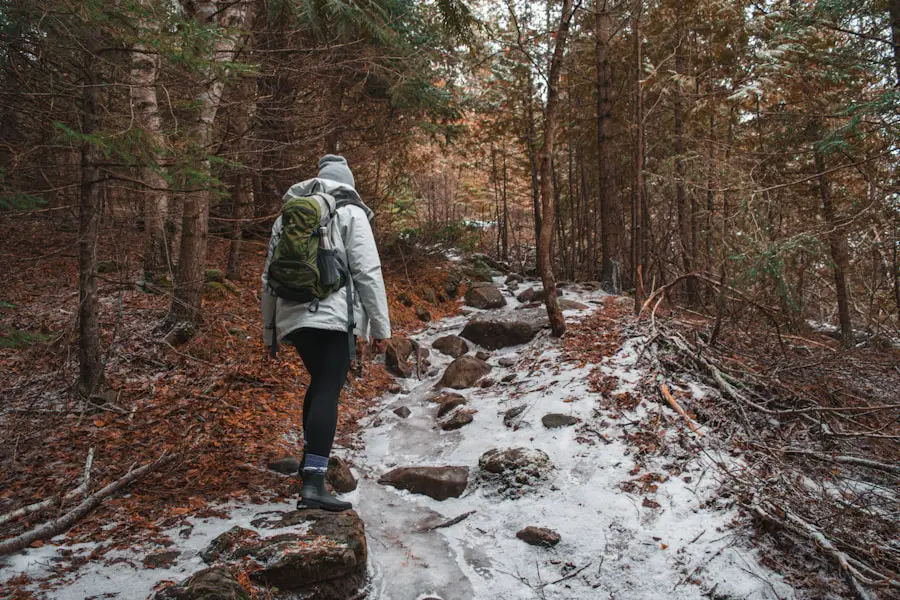Layering is a fundamental principle in outdoor clothing that allows for versatility and adaptability in varying weather conditions. The concept revolves around wearing multiple layers of clothing, each serving a specific purpose, which can be adjusted according to the temperature and activity level. The base layer, typically made from moisture-wicking materials, sits closest to the skin and is designed to manage sweat.
This layer is crucial because it helps regulate body temperature by drawing moisture away from the skin, keeping you dry and comfortable during physical exertion. For instance, a synthetic or merino wool base layer can effectively wick away moisture while providing warmth. The middle layer serves as insulation, trapping heat to keep the body warm.
Fleece jackets or down vests are popular choices for this layer, as they provide excellent thermal retention without adding excessive bulk. The outer layer, often referred to as the shell, protects against wind, rain, and snow. This layer is typically made from waterproof or water-resistant materials that allow moisture to escape while preventing external elements from penetrating.
By combining these three layers, outdoor enthusiasts can easily adjust their clothing to suit changing conditions, ensuring comfort and protection throughout their adventures.
Key Takeaways
- Layering is key for staying comfortable and regulating body temperature during outdoor activities.
- Choose moisture-wicking fabrics to keep sweat away from your skin and stay dry.
- Don’t forget a waterproof jacket to stay dry and protected from the elements.
- Opt for comfortable, supportive footwear to prevent blisters and provide stability on uneven terrain.
- Protect your extremities by wearing gloves, socks, and a hat to keep warm and prevent frostbite.
Choose Moisture-Wicking Fabrics
Selecting the right fabrics is essential for maintaining comfort during outdoor activities, particularly when engaging in strenuous exercise. Moisture-wicking fabrics are engineered to draw sweat away from the skin and facilitate evaporation, which helps regulate body temperature and prevents the discomfort associated with damp clothing. Common materials used for moisture-wicking garments include polyester, nylon, and merino wool.
These fabrics not only manage moisture effectively but also dry quickly, making them ideal for active pursuits such as hiking, running, or cycling. For example, a polyester blend shirt designed for running can keep you dry during a long-distance race by pulling sweat away from your body and allowing it to evaporate quickly. Merino wool, on the other hand, offers natural moisture-wicking properties along with temperature regulation, making it suitable for both warm and cool weather.
When choosing moisture-wicking fabrics, it’s important to consider the garment’s fit and construction as well; seams should be flat to prevent chafing, and the fabric should have some stretch to allow for a full range of motion. By prioritizing moisture-wicking materials in your outdoor wardrobe, you can enhance your overall experience and performance.
Don’t Forget a Waterproof Jacket

A waterproof jacket is an indispensable piece of gear for anyone venturing into the great outdoors. Weather conditions can change rapidly, and being caught in rain or snow without proper protection can lead to discomfort and even hypothermia in extreme cases. A high-quality waterproof jacket not only shields you from precipitation but also provides breathability to prevent overheating during physical activity.
Look for jackets made with advanced materials such as Gore-Tex or similar technologies that offer both waterproofing and breathability. When selecting a waterproof jacket, consider features such as adjustable hoods, cuffs, and hemlines that allow for a customizable fit. Ventilation zippers can also be beneficial for regulating temperature during intense activities.
For instance, a hiker might appreciate a jacket with underarm vents that can be opened while climbing steep trails to release excess heat. Additionally, pockets are essential for storing small items like maps or snacks while keeping them dry. Investing in a reliable waterproof jacket ensures that you remain comfortable and protected against the elements, allowing you to focus on enjoying your outdoor experience.
Opt for Comfortable, Supportive Footwear
| Brand | Comfort Rating | Support Rating |
|---|---|---|
| Nike | 4.5 | 4.2 |
| Adidas | 4.3 | 4.0 |
| New Balance | 4.7 | 4.5 |
| Asics | 4.6 | 4.3 |
Footwear is one of the most critical components of any outdoor outfit, as it directly impacts comfort and performance during activities such as hiking or trekking. Choosing the right shoes or boots involves considering factors such as terrain, distance, and personal foot shape. Supportive footwear is essential for preventing injuries and ensuring stability on uneven surfaces.
Hiking boots with ankle support can help reduce the risk of sprains on rocky trails, while trail running shoes may offer a lighter option for those seeking speed on well-maintained paths. In addition to support, comfort is paramount when selecting outdoor footwear. Look for shoes with cushioned insoles that provide shock absorption and reduce fatigue over long distances.
Breathable materials are also important to keep feet dry and comfortable during extended wear. For example, a pair of waterproof hiking boots with breathable mesh panels can keep your feet dry in wet conditions while allowing moisture to escape during warmer days. It’s advisable to try on footwear with the socks you plan to wear during your activities to ensure a proper fit.
By investing in comfortable and supportive footwear, you can enhance your outdoor experience and minimize the risk of blisters or discomfort.
Protect Your Extremities
When spending time outdoors, protecting your extremities—hands, feet, and head—is crucial for maintaining overall comfort and safety. Extremities are particularly vulnerable to temperature fluctuations and harsh weather conditions; therefore, appropriate gear is essential. For hands, insulated gloves or mittens are recommended to keep fingers warm in cold weather.
Mittens tend to provide better warmth since they allow fingers to share heat; however, gloves offer more dexterity for tasks like adjusting gear or handling equipment. Foot protection extends beyond just choosing the right footwear; it also includes wearing appropriate socks. Wool or synthetic socks designed for outdoor activities can help wick moisture away from the feet while providing cushioning and warmth.
In colder conditions, consider using sock liners for added insulation. Additionally, hats are vital for protecting your head from both cold temperatures and sun exposure. A warm beanie can keep heat from escaping in winter months, while a wide-brimmed hat can shield your face from harmful UV rays during summer hikes.
By taking measures to protect your extremities, you can ensure a more enjoyable outdoor experience regardless of the weather.
Consider a Hat and Sunglasses

A hat and sunglasses are often overlooked accessories that play a significant role in outdoor comfort and protection. A good hat serves multiple purposes: it provides shade from the sun, keeps rain off your face, and helps regulate body temperature by shielding your head from direct sunlight. When choosing a hat for outdoor activities, consider options with wide brims that offer maximum coverage or those with ventilation features that allow airflow while keeping you cool.
Sunglasses are equally important for protecting your eyes from harmful UV rays and reducing glare from reflective surfaces like water or snow. Look for sunglasses with polarized lenses that enhance visibility by minimizing glare while providing 100% UV protection. This is particularly crucial when engaging in activities like skiing or snowboarding where snow blindness can occur due to intense sunlight reflecting off the snow surface.
Additionally, consider sunglasses with adjustable nose pads or temple arms for a secure fit during vigorous activities. By incorporating a hat and sunglasses into your outdoor gear collection, you can enhance your comfort while safeguarding against environmental elements.
Pack a Daypack for Essentials
A daypack is an essential accessory for any outdoor adventure, providing a convenient way to carry necessary items without hindering mobility or comfort. When selecting a daypack, consider its size based on the duration of your outing and the items you need to bring along. A pack with a capacity of 15-30 liters is typically sufficient for day hikes or short excursions, allowing enough space for essentials like water bottles, snacks, first aid kits, maps, and extra layers of clothing.
Look for features that enhance functionality and comfort in your daypack design. Adjustable straps ensure a snug fit while distributing weight evenly across your back and shoulders. Pockets and compartments help organize gear efficiently; external mesh pockets are ideal for storing water bottles or quick-access items like energy bars.
Hydration reservoirs are another excellent feature that allows you to sip water without stopping frequently during your hike.
By packing a well-organized daypack with all necessary essentials, you can focus on enjoying your outdoor experience without worrying about forgetting important items.Be Prepared for Changing Conditions
Outdoor environments are inherently unpredictable; therefore, being prepared for changing conditions is vital for safety and enjoyment during any adventure. Weather forecasts can provide valuable information before heading out; however, conditions can shift rapidly due to factors such as elevation changes or local microclimates. Carrying extra layers of clothing allows you to adapt quickly if temperatures drop or if rain begins unexpectedly.
In addition to clothing adjustments, having contingency plans in place is essential when facing sudden changes in weather or trail conditions. Familiarize yourself with the area you plan to explore by studying maps and understanding potential hazards such as river crossings or steep terrain that may become slippery when wet. Carrying navigation tools like compasses or GPS devices ensures you remain oriented even if visibility decreases due to fog or rain.
Moreover, it’s wise to pack emergency supplies such as a whistle, flashlight, or multi-tool in case of unforeseen circumstances that require assistance or repairs on the trail. By being proactive about potential changes in conditions and preparing accordingly, you can enhance your safety and overall experience while enjoying the great outdoors.
If you’re planning a hiking trip in 40-50 degree weather, it’s important to dress appropriately to stay comfortable and safe on the trails. Check out this article for tips on what to wear during your outdoor adventure. From layering up with moisture-wicking fabrics to choosing the right footwear, this guide will help you make the most of your hiking experience.
FAQs
What should I wear for hiking in 40-50 degree weather?
In 40-50 degree weather, it’s important to wear layers to stay warm and dry. Start with a moisture-wicking base layer, add an insulating layer, and finish with a waterproof and windproof outer layer.
What are some examples of moisture-wicking base layers?
Moisture-wicking base layers can include synthetic materials like polyester or merino wool. These materials help to pull sweat away from the skin and keep you dry and comfortable during your hike.
What are some examples of insulating layers for 40-50 degree weather?
Insulating layers can include fleece jackets, down jackets, or synthetic insulated jackets. These layers help to trap body heat and keep you warm during your hike.
What should I look for in a waterproof and windproof outer layer?
Look for a waterproof and windproof jacket that has sealed seams and adjustable cuffs and hems to keep out the elements. It’s also important to choose a jacket with good breathability to prevent overheating and sweating.
What type of pants are suitable for hiking in 40-50 degree weather?
For hiking in 40-50 degree weather, consider wearing moisture-wicking and quick-drying hiking pants. You can also opt for convertible pants that can be converted into shorts if the weather warms up.
What kind of footwear is recommended for hiking in 40-50 degree weather?
Choose hiking boots or shoes that provide good ankle support and traction. Look for waterproof and breathable options to keep your feet dry and comfortable during your hike.
What accessories should I bring for hiking in 40-50 degree weather?
Consider bringing a hat, gloves, and a scarf or neck gaiter to protect your head, hands, and neck from the cold. It’s also important to bring sunglasses and sunscreen to protect against UV rays, even in cooler temperatures.
